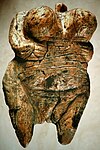Paleolithic Europe
Paleolithic Europe, or Old Stone Age Europe, encompasses the
Overview
The period is divided into:
- the Lower Paleolithic, from the earliest human presence (Homo antecessor and Homo heidelbergensis)[2] to the Holstein interglacial, c. 1.4 to 0.3 million years ago;
- the Neanderthals, 300,000 to 40,000 years ago;[2]
- the anatomically modern humans and extending throughout the Last Glacial Maximum;[4]
- the Mesolithic or Epipaleolithic, beginning about 14,000 years ago and extending until as late as 4,000 years ago in northern Europe. The Mesolithic may or may not be included as the final phase of the Upper Paleolithic.[2]
Paleolithic
Lower Paleolithic: 1.4 mya – 300,000 BP
The oldest evidence of human occupation in Eastern Europe comes from the
The earliest evidence for the use of the more advanced Mode 2-type assemblages
The oldest complete hunting weapons ever found anywhere in the world were discovered in 1995 in a coal mine near the town Schöningen, Germany, where the Schöningen spears, eight 380,000-year-old wooden javelins were unearthed.[10]
Middle Paleolithic: 300,000–50,000 BP

Elements of the European and African Homo erectus populations evolved between 800,000 and 400,000 years ago through a series of intermediate speciations towards
Experts debate over whether the "Divje Babe flute" from the Divje Babe I cave is evidence—based on if the object is an actual flute—that the Middle Paleolithic Neanderthal inhabitants of Europe may have made and used musical instruments.[20]
Upper Paleolithic: 50,000–10,000 BP
The earliest modern human which have been directly dated are from 46,000 to 44,000 years ago in the Bacho Kiro cave, located in present-day Bulgaria. They are associated with the Initial Upper Paleolithic (IUP), the earliest culture of modern humans in Europe.[21][22] These people do not appear to have been the ancestors of later Europeans as the very few ancient DNA (aDNA) samples recovered from this period are not related to later samples.[23]
Aurignacian
The IUP was followed by the Aurignacian. The origins of this culture can be located in Eastern Europe, in what is now Bulgaria (proto-Aurignacian) and Hungary (first full Aurignacian). By 35,000 BCE, the Aurignacian culture and its technology had extended through most of Europe.[24][25] Studies of aDNA have found an association between 35,000 year old Aurignacian remains in the Goyet Cave system in Belgium and Mesolithic hunter-gatherers in Western Europe. The same aDNA signature is found in the intervening period in Iberia, suggesting that the area was a refuge for hunter-gatherers at the height of the Last Glacial Maximum.[23]
Gravettian
Around 32,000 BCE, the
The Solutrean culture, extended from northern Spain to southeastern France, includes not only an advanced
The more widespread Gravettian culture is no less advanced, at least in artistic terms: sculpture (mainly venuses) is the most outstanding form of creative expression of these peoples.[4]
Transition to the Mesolithic
Around 17,000 BCE, Europe witnesses the appearance of a new culture, known as
With the Magdalenian culture, Paleolithic development in Europe reaches its peak and this is reflected in the advanced art, owing to the previous traditions of painting in the West and sculpture in Central Europe.[28]

Around 10,500 BCE, the
In the late phase of this
See also
References
- ISBN 978-3-540-32474-4.
- ^ a b c d Groeneveld, Emma (29 September 2017). "Paleolithic". World History Encyclopedia. Retrieved 22 January 2019.
- ISBN 9781108590891.
- ^ PMID 28542642.
- ^ Musée de Préhistoire Terra Amata. "Le site acheuléen de Terra Amata" [The Acheulean site of Terra Amata]. Musée de Préhistoire Terra Amata (in French). Retrieved 10 June 2022.
- .
- PMID 14504393.
- S2CID 20435482.
- PMID 24278105.
- S2CID 4238514. Retrieved 12 January 2019.
- ^ "Early Human Evolution: Homo ergaster and erectus". palomar edu. Archived from the original on 19 December 2007. Retrieved 13 January 2019.
- ^ Cookson, Clive (27 June 2014). "Palaeontology: How Neanderthals evolved". Financial Times. Retrieved 28 October 2015.
- S2CID 88427585.
- ^ "Oldest Ancient-Human DNA Details Dawn of Neandertals". Scientific American. 14 March 2016. Retrieved 26 September 2016.
- ^ "Homo heidelbergensis – Comparison of Neanderthal and modern human DNA suggests that the two lineages diverged from a common ancestor, most likely Homo heidelbergensis". Smithsonian Institution. 14 February 2010. Retrieved 26 September 2016.
- ^ Edwards, Owen (March 2010). "The Skeletons of Shanidar Cave". Smithsonian Magazine. Retrieved 17 October 2014.
- ^ "Neanderthal Anthropology". Encyclopædia Britannica. 2015. Retrieved September 26, 2016.
Neanderthals inhabited Eurasia from the Atlantic regions…
- ISBN 978-0-631-17423-3. Retrieved 1 August 2016.
- ^ "Homo neanderthalensis". Smithsonian Institution. September 22, 2016. Retrieved September 26, 2016.
...The Mousterian stone tool industry of Neanderthals is characterized by…
- ISBN 978-961-6182-29-4.
- S2CID 218592678.
- ^ Bower, Bruce (11 May 2020). "The earliest known humans in Europe may have been found in a Bulgarian cave". Science News.
- ^ a b Callaway, Ewen (1 March 2023). "Ancient genomes show how humans escaped Europe's deep freeze". Nature News.
- ISBN 978-1-4419-6633-9. Retrieved 22 January 2019.
One of the earliest dates for an Aurignacian assemblage is greater than 43,000 BP from Bacho Kiro cave in Bulgaria ...
- ^ "Skull fragment sheds light on Neanderthal and human interbreeding". The Daily Telegraph. 28 January 2015. Retrieved 22 January 2019.
- .
- ^ Carpenter, Jennifer (20 June 2011). "Early human fossils unearthed in Ukraine". BBC. Retrieved 21 June 2011.
- .
- ISBN 978-3-319-51726-1.
- ^ Medved, Ines. "Continuity vs. Discontinuity, Epipaleolithic and Early Neolithic in the Mediterranean Southeast of the Iberian Peninsula" (PDF). University of Cologne. Retrieved 22 January 2019.
- ^ "Mesolithic Culture of Europe" (PDF). e-Acharya INFLIBNET. Retrieved 22 January 2019.
External links
Paleolithic sites in France:
- Culture.gouv.fr: Lascaux (in English)
- Culture.gouv.fr: Chauvet (in French)




